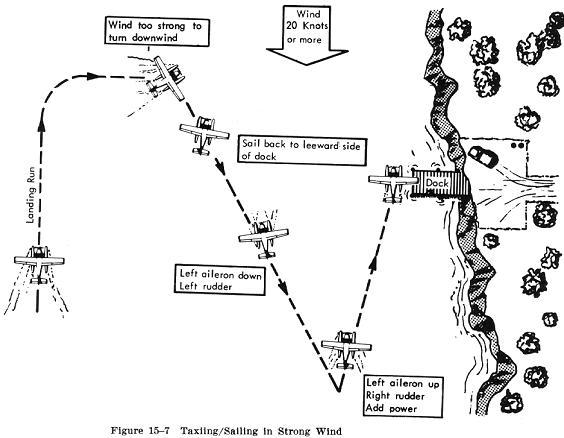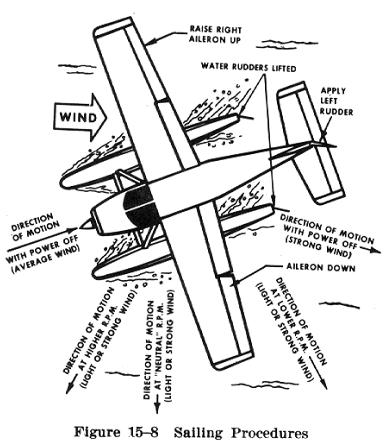
Occasions often arise when it is advisable to move the seaplane backward or to one side because wind or water conditions, or limited space make it impractical to attempt a turn (Fig. 15-7). In this situation, particularly if there is a significant wind, the seaplane can be "sailed" into a space which to an inexperienced pilot might seem extremely cramped. Even if the wind is calm and the space is inadequate for making a normal turn, a paddle (which should be part of every seaplane's equipment) may be used to propel the seaplane or to turn the nose in the desired direction.

 |
In light wind conditions with the engine idling or shut down, the seaplane
will naturally weathervane into the wind and then sail in the direction
the tail is pointed (Fig. 15-8). With a stronger wind and a slight amount
of power, the seaplane will usually sail downwind toward the side in which
the nose is pointed. Rudder and aileron can be deflected to create drag
on the appropriate side to control the direction of movement. Positioning
the controls for the desired direction of motion in light or strong winds
is illustrated in Fig. 15-8. Lowering the wing flaps and opening the cabin
doors will increase the air resistance and thus add to the effect of the
wind; however, the effect of the air rudder may be reduced in this configuration.
Since water rudders have little or no effect in controlling direction while
sailing, they should be lifted.
With the engine shut down, most flying boats will sail backward and toward the side to which the nose is pointed, much as a sailboat tacks, regardless of wind velocity because the hull does not provide as much keel (side area) as do floats in proportion to the size of the seaplane. To sail directly backward in a seaplane having a hull, the controls should be released and the wind allowed to steer the seaplane. |
During initial seaplane training, sailing should be practiced in large bodies of water such as lakes or bays, but sufficiently close to a prominent object in order to evaluate performance. Where there are strong tides or a rapidly flowing current, such as in rivers, care must be taken in observing the relative effect of both the wind and the water current. Often the force of the current will be equal to or greater than the force of the wind.
Before taxiing into a confined area, the effect of wind and the current should be considered carefully. Otherwise, the seaplane may be carried into obstructions with resulting damage to the wings, tail surfaces, floats, hull, or other parts of the seaplane. Generally, with a seaplane of average size and power at idle, a water current of 5 knots will more than offset a wind velocity of 25 knots. This means that the seaplane will move against the wind.
When operating multiengine seaplanes, differential power can be used to aid in steering the seaplane along a desired course.